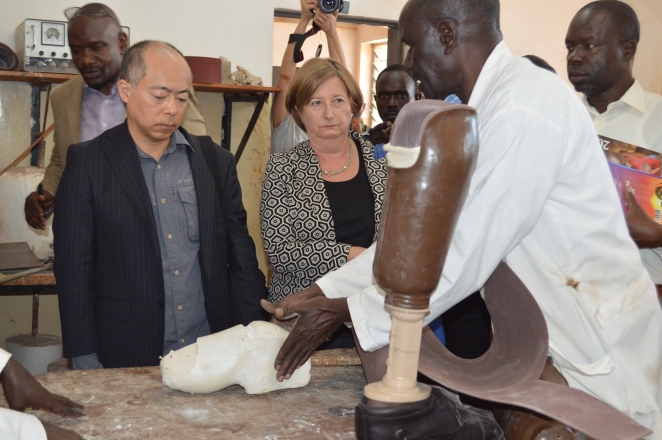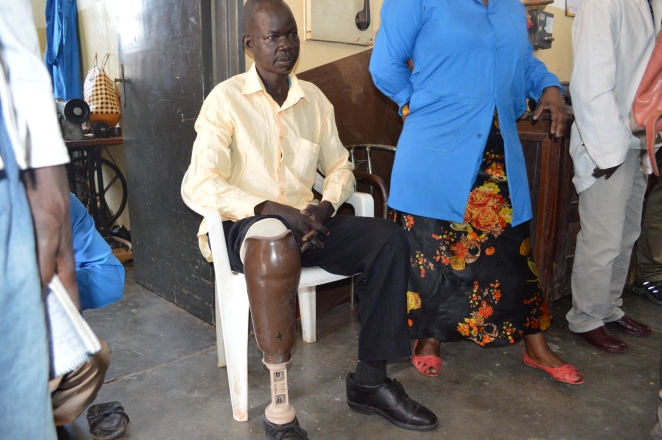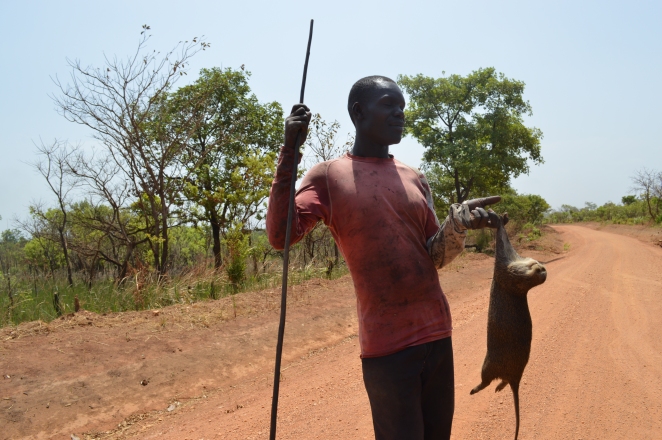By
Abalo Irene Otto
“Move your limb, try to move it a bit. No no no, not like that. Let’s try again.” An orthopedic therapist tells an amputee. “Good. Take another step.”
These are instructors at the orthopedic department of Gulu Regional Referral Hospital. The amputee, Justine Olweny is trying his new artificial limbs made at the orthopedic workshop.
The workshop makes about four artificial limbs every month for patients from the 7 districts of Acholi Sub region and beyond. At the workshop, priority is given to land mine survivors of the two decade Lord’s Resistance Army (LRA) insurgency.

Photo: An orthopedic explains to ICC officials Motoo Noguchi (L) and Judge Fenandez (R) how a Swiss limb is made at orthopedic workshop at Gulu Regional Referral Hospital early this month.
Today Ojwany Justine 57, from Atiak Sub County, Amuru district is learning to take his first step after stepping on a land mine in 2003.
Ojwang is a double amputee, he has to balance his weight to take the first step says Lucy Angee, the physiotherapist training him how to work. It will take Ojwang about one month to walk on his new limbs made from Gulu Regional Referral Hospital Orthopedic Workshop.
“It is difficult to learn how to walk at my age. I feel helpless but I have to practice so that I can do something to care for my family.” Opiyo tells this paper while standing with the support of his artificial limb holding a pair of crochets.

Photo: A land mind survivor fitted with a new Swiss artificial limb at the orthopedic workshop of Gulu Regional Referral Hospital.
Irene Laker, 36 years, a former business woman from Pece Tegwana, Gulu Municipality lost her left limb to land mine In August 2002 after an attack by the LRA in her area.
“Life was difficult and I had to turn to God for Courage. I recovered but life was hard because I would always fall down due to imbalance.” Narrates Irene,” When I got my artificial limbs, life changed and things were a lot easier for me.” She adds with a smile.
Hawa Muhumuza, an orthopedic technologist at Gulu Regional Referral Hospital says they patients come to the workshop hopeless and weary.
“On getting their limbs fixed, it’s not easy but it is always a joy to watch them hope for a better life. Our prayer is that they find their fulfilment in life with these artificial limbs that we give them free of charge.” Says the orthopedic technologist.
At 76 years, Alice Acayo is an amputee in the upper right knee due to land mine planted near her home in Lamwo 11 years ago by LRA rebels. She is at the orthopedic workshop to have her worn out limbs replaced after using it for five years.
Fetching water and selling at a local market in Lamwo town is what Alice does to earn a living after getting her artificial limb from Gulu Orthopedic Workshop five years ago.
“Because of my new limbs, I can now do some things on my own without assistance which makes me happy. People were tired of lending a hand always.” Says a joyful Alice to ICC President Fernandez.
Judge Silvia Fernandez de Gurmendi, the president of the International Criminal Court (ICC) was in Uganda early this month to visit victims of the Lord’s Resistance Army rebels benefiting from Trust Fund for Victims assistance projects in Northern Uganda. She says the fund can only support a few but not all who need assistance.
Trust Fund for Victims is supporting war victims with physical rehabilitation through local partners like AVSI that is supporting the orthopedic works to provide free limbs to the disadvantaged communities who cannot afford orthopedic services on their own.
Dr Augustine Mindra, the senior Orthopedic at Gulu Regional Referral Hospital says a limb in private facilities could cost between 1million to 1.5 million depending on the service provider.
He encouraged amputees to access the free orthopedic service at the Gulu Regional Referral Hospital to improve their livelihoods.
Approximately 45,000 war victims have benefited from the Trust Fund for Victims in the last eight years since the ICC started channeling funds to war victims in Uganda. The funds were used in physical and psychosocial rehabilitation, support livelihood programs and medical operations of those with bullet wounds and shrapnel in their bodies.





